I would like to make a lognormal fit to my already binned data. The bar plot looks like this: 
Unfortunately, when I try to use the standard lognorm.pdf() the shape of the fitted distribution is very different. I guess it's because my data is already binned. Here's the code:
times, data, bin_points = ReadHistogramFile(filename)
xmin = 200
xmax = 800
x = np.linspace(xmin, xmax, 1000)
shape, loc, scale = stats.lognorm.fit(data, floc=0)
pdf = stats.lognorm.pdf(x, shape, loc=loc, scale=scale)
area=data.sum()
plt.bar(bars, data, width=10, color='b')
plt.plot(x*area, pdf, 'k' )
Here's what the fitted distribution looks like:
 Obviously there's something wrong also with the scaling. I'm less concerned about that though. My main issue is, the shape of the distribution. This might be duplicate to: this question but I could not find a correct solution. I tried it and still get a very similar shape as when doing the above. Thanks for any help!
Obviously there's something wrong also with the scaling. I'm less concerned about that though. My main issue is, the shape of the distribution. This might be duplicate to: this question but I could not find a correct solution. I tried it and still get a very similar shape as when doing the above. Thanks for any help!
Update:
By using curve_fit() I was able to get somewhat of a fit. But I'm not satisfied yet. I'd like to have the original bins and not unity-bins. Also I'm not sure, what exactly is happening, and if there is not a better fit. Here's the code:
def normalize_integral(data, bin_size):
normalized_data = np.zeros(size(data))
print bin_size
sum = data.sum()
integral = bin_size*sum
for i in range(0, size(data)-1):
normalized_data[i] = data[i]/integral
print 'integral:', normalized_data.sum()*bin_size
return normalized_data
def pdf(x, mu, sigma):
"""pdf of lognormal distribution"""
return (np.exp(-(np.log(x) - mu)**2 / (2 * sigma**2)) / (x * sigma * np.sqrt(2 * np.pi)))
bin_points=np.linspace(280.5, 1099.55994, len(bin_points))
data=[9.78200000e+03 1.15120000e+04 1.18000000e+04 1.79620000e+04 2.76980000e+04 2.78260000e+04 3.35460000e+04 3.24260000e+04 3.16500000e+04 3.30820000e+04 4.84560000e+04 5.86500000e+04 6.34220000e+04 5.11880000e+04 5.13180000e+04 4.74320000e+04 4.35420000e+04 4.13400000e+04 3.60880000e+04 2.96900000e+04 2.66640000e+04 2.58720000e+04 2.57560000e+04 2.20960000e+04 1.46880000e+04 9.97200000e+03 5.74200000e+03 3.52000000e+03 2.74600000e+03 2.61800000e+03 1.50000000e+03 7.96000000e+02 5.40000000e+02 2.98000000e+02 2.90000000e+02 2.22000000e+02 2.26000000e+02 1.88000000e+02 1.20000000e+02 5.00000000e+01 5.40000000e+01 5.80000000e+01 5.20000000e+01 2.00000000e+01 2.80000000e+01 6.00000000e+00 0.00000000e+00 0.00000000e+00 0.00000000e+00 0.00000000e+00 0.00000000e+00 0.00000000e+00 0.00000000e+00 0.00000000e+00 0.00000000e+00 0.00000000e+00 0.00000000e+00 0.00000000e+00 0.00000000e+00 0.00000000e+00 0.00000000e+00 0.00000000e+00 0.00000000e+00 0.00000000e+00 0.00000000e+00 0.00000000e+00 0.00000000e+00 0.00000000e+00 0.00000000e+00 0.00000000e+00 0.00000000e+00 0.00000000e+00 0.00000000e+00 0.00000000e+00]
normalized_data_unitybins = normalize_integral(data,1)
plt.figure(figsize=(9,4))
ax1=plt.subplot(121)
ax2=plt.subplot(122)
ax2.bar(unity_bins, normalized_data_unitybins, width=1, color='b')
fitParams, fitCov = curve_fit(pdf, unity_bins, normalized_data_unitybins, p0=[1,1],maxfev = 1000000)
fitData=pdf(unity_bins, *fitParams)
ax2.plot(unity_bins, fitData,'g-')
ax1.bar(bin_points, normalized_data_unitybins, width=10, color='b')
fitParams, fitCov = curve_fit(pdf, bin_points, normalized_data_unitybins, p0=[1,1],maxfev = 1000000)
fitData=pdf(bin_points, *fitParams)
ax1.plot(bin_points, fitData,'g-')

